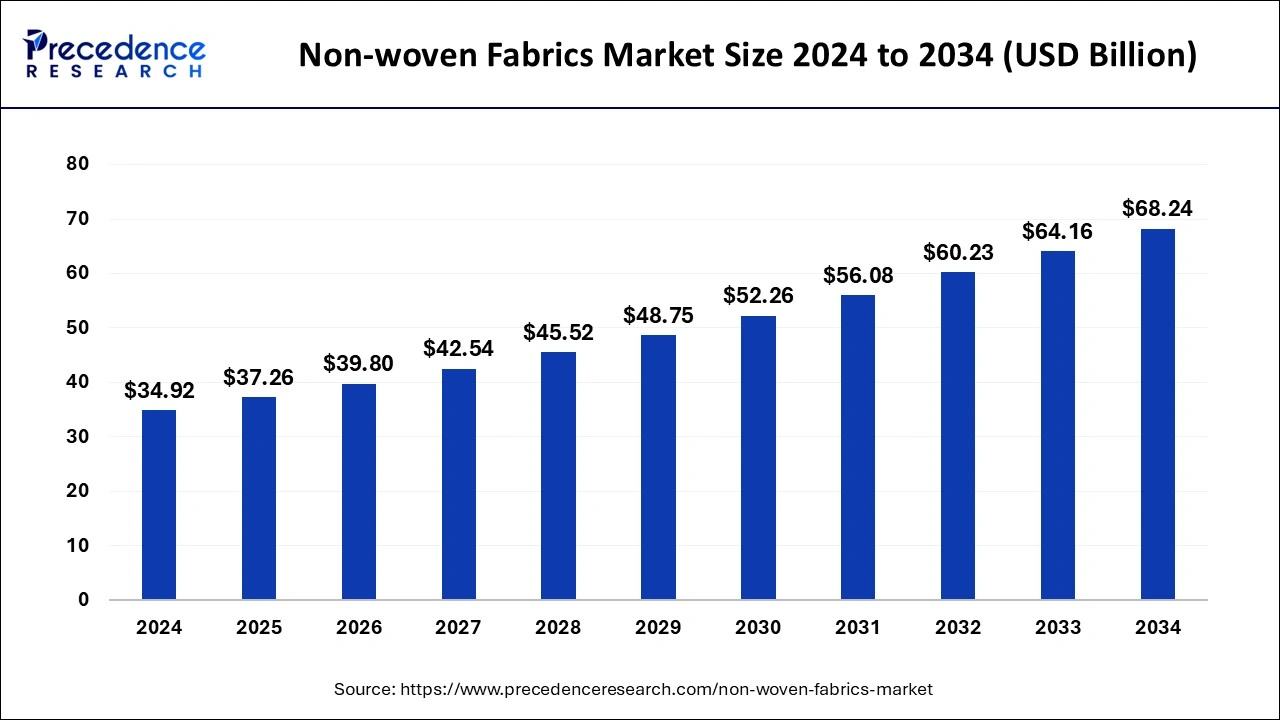Non-woven Fabrics Market Size to Hit USD 68.24 Bn by 2034
The global non-woven fabrics market size was valued at USD 34.92 billion in 2024 and is expected to hit USD 68.24 billion by 2034 with a CAGR of 6.92% from 2025 to 2034.

Get Sample Copy of Report@ https://www.precedenceresearch.com/sample/1147
Key Highlights
- Asia Pacific held the leading position in the non-woven fabrics market in 2024, contributing 41% of the total share.
- The polypropylene category led the market, representing 60% of the overall demand.
- With a 50% revenue share, the durables segment was the highest-earning application.
AI Impact on the Non-Woven Fabrics Market
Artificial Intelligence (AI) is transforming the non-woven fabrics market by enhancing production efficiency, improving quality control, enabling predictive maintenance, and fostering sustainability. The integration of AI-driven technologies is helping manufacturers optimize processes, reduce waste, and meet the growing demand for high-performance and eco-friendly fabrics.
1. AI in Manufacturing & Automation
- Smart Production Lines – AI-powered automation improves fabric production by optimizing fiber bonding techniques, reducing human intervention, and increasing precision.
- Process Optimization – Machine learning algorithms analyze production data to optimize raw material usage, energy consumption, and production speeds.
- Quality Control & Defect Detection – AI-driven computer vision systems detect flaws in non-woven fabrics, ensuring higher product quality with minimal errors.
2. AI for Predictive Maintenance & Supply Chain Efficiency
- Predictive Maintenance – AI-enabled sensors monitor machinery performance, predicting failures before they occur and reducing downtime.
- Supply Chain Optimization – AI-driven analytics improve inventory management, ensuring timely raw material procurement and efficient logistics.
3. AI in Product Development & Innovation
- Material Engineering – AI simulations help in developing innovative, sustainable, and high-performance non-woven fabrics with better durability and functionality.
- Customization & Smart Textiles – AI enables the design of specialized non-woven fabrics tailored for specific industries, such as biodegradable materials or temperature-regulating textiles.
4. AI for Sustainability & Environmental Impact
- Waste Reduction & Recycling – AI-driven sorting and recycling systems enhance the reusability of non-woven fabric waste, reducing environmental impact.
- Energy Efficiency – AI optimizes energy consumption in manufacturing plants, contributing to greener production processes.
Introduction to Non-Woven Fabrics
Non-woven fabrics are specially engineered materials produced by bonding fibers using mechanical, chemical, or thermal methods instead of traditional weaving or knitting. These fabrics are lightweight, strong, and cost-effective, making them essential across multiple industries, including healthcare, automotive, construction, and hygiene.
Types of Non-Woven Fabrics
- Spunbond Non-Woven Fabric – Created by extruding and bonding continuous filaments, commonly used in medical masks, reusable shopping bags, and agricultural covers.
- Meltblown Non-Woven Fabric – Features ultra-fine fibers with excellent filtration efficiency, ideal for face masks, air filters, and medical applications.
- Needle-Punched Non-Woven Fabric – Manufactured through fiber entanglement for enhanced durability, widely used in carpets, insulation, and automotive components.
- Hydroentangled (Spunlace) Non-Woven Fabric – Offers high softness and absorbency, making it suitable for wipes, tissues, and various medical products.
- Composite Non-Woven Fabric – Combines multiple manufacturing techniques to improve strength and functionality for diverse applications.
Applications of Non-Woven Fabrics
- Medical & Healthcare – Utilized in surgical gowns, face masks, bandages, drapes, and hygiene products like diapers and sanitary pads.
- Automotive Industry – Applied in car seat upholstery, headliners, carpets, and insulation materials.
- Construction Sector – Used for geotextiles, roofing materials, and insulation solutions.
- Personal Care & Hygiene – Found in diapers, sanitary napkins, wet wipes, and adult hygiene products.
- Agriculture – Used for greenhouse shading, soil protection, and crop covers.
- Packaging Industry – Applied in reusable shopping bags, food packaging, and disposable tea bags.
Benefits of Non-Woven Fabrics
- Lightweight yet durable
- High absorption and superior filtration
- Affordable and easy to manufacture
- Versatile for various industrial uses
- Eco-friendly options, including biodegradable materials
Market Trends and Growth Drivers
- Rising Healthcare Demand – Increased consumption of disposable medical products, particularly post-COVID-19, has fueled market growth.
- Automotive Industry Expansion – Greater adoption of lightweight and sustainable materials in vehicle manufacturing.
- Sustainability Initiatives – Growing preference for biodegradable and recyclable non-woven fabrics.
- Asia Pacific Market Leadership – Rapid industrialization and urban growth have made Asia Pacific the largest consumer of non-woven fabrics.
Non-woven Fabrics Market Scope
| Report Highlights | Details |
| Market Size in 2025 | USD 37.26 Billion |
| Market Size by 2034 | USD 68.24 Billion |
| Market Growth Rate from 2025 to 2034 | CAGR of 6.92% |
| Largest Market | Asia Pacific |
| Base Year | 2024 |
| Forecast Period | 2025 to 2034 |
| Segments Covered | Product, Application, and Region |
| Regions Covered | North America, Europe, Asia-Pacific, Latin America and Middle East & Africa |
Also Read: https://www.newsgazzete.com/stand-up-pouches-market/
Non-woven Fabrics Market Companies
DuPont
-
Investment in Capacity: DuPont plans to invest over $400 million to expand its Tyvek® nonwoven materials manufacturing capacity in Luxembourg, highlighting its commitment to meeting growing global demand across various applications, including building materials and medical packaging.
-
Innovative Applications: Tyvek® is used extensively in protective garments, medical packaging, and building envelope solutions, setting standards for safety and performance in multiple industries.
-
Sustainability Initiatives: DuPont is focusing on sustainability by enhancing the recyclability of Tyvek products and collaborating with customers to improve environmental impact.
- Ahlstrom Incorporation
- Polymer Group Incorporation
- Fiberweb
- Asahi Kasei Corporation
- AVGOL
- Providencia
- First Quality
- PEGAS
- Mitsui
- Fibertex
- Fitesa
- Toray
Ready for more? Dive into the full experience on our website@ https://www.precedenceresearch.com/
